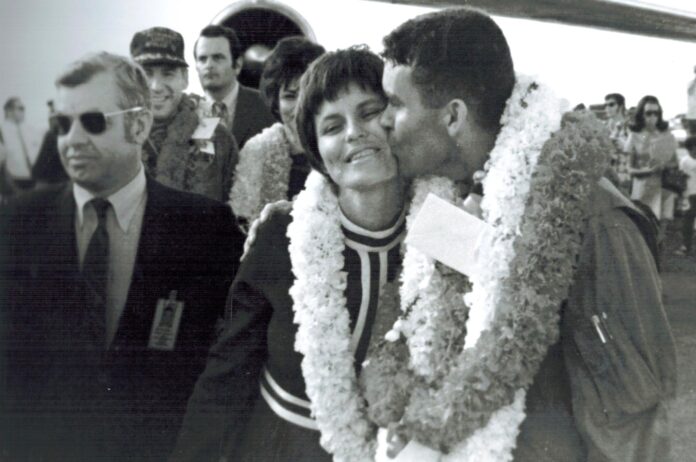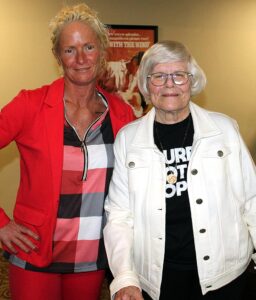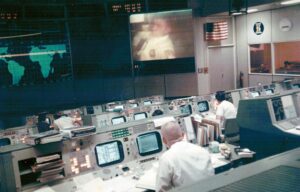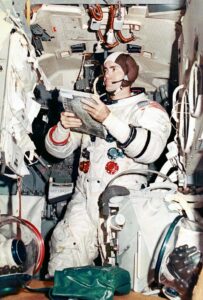
For a time in 1970, Mary Haise was at the center of a media firestorm because her husband, astronaut Fred Haise, was on Apollo 13 when an explosion left the fate of the three astronauts onboard in question.

The astronauts returned safely to Earth after two nerve-wracking days while the Earth held its collective breath, and they and their wives became celebrities, wined and dined at the White House, flying on Air Force One, staying at Camp David and embarking on a European tour to meet heads of state.
Life returned to normal after those heady experiences, and Mary and Fred raised their four children; they later divorced but remained friends. Mary eventually settled in Summerfield for 18 years, moved away for three years and came back this March, moving into Summerfield Estates.
April 11 was the 52nd anniversary of the lift-off of Apollo 13, and Estates Community Development Director Angela Lile decided to honor Mary with a celebration of Apollo 13, decorating the facility with astronaut and spaceship balloons, and inviting the media to meet her and hear her story.
Mary shared her story a second time with Estates residents later in the week, explaining how she and Fred were high school sweethearts in Beloxi, Miss.; they later married and moved around the country as Fred went on to get his wings from the Navy, joined the Marine Corps, earned a second degree in aeronautical engineering and ended up at Edwards Air Force Base.
Fred joined NASA and applied for the astronaut program along with 600 others, and he was one of 19 to be selected. The couple moved to Houston in 1966, where the astronauts and their families lived in close proximity to each other.

Fred was part of the back-up crew for Apollo 11, which in 1969 carried Neil Armstrong, Michael Collins and “Buzz” Aldrin to the moon and back. “We went to the Cape (Canaveral) for the lift-off,” Mary said. “The astronauts’ families were kept away from the crowds and the press. Charles and Anne Lindbergh were there, and when my 10-year-old son Fred, who had read about Lindbergh in his history books, met him, he said, ‘You’re dead!’”
Apollo 12 made a successful moon landing, and then it was Apollo 13’s turn. Mary was seven months pregnant when Apollo 13 lifted off, and the families remained in Houston, watching the lift-off at Mission Control. The explosion happened on the third day.
“We each had a little black box on our TV set that connected us with Mission Control, and each astronaut family had a NASA representative who moved into our home,” Mary said. “On the third day of the mission, we were returning home. I was opening the front door, and he was on the phone when he yelled at me, “Don’t go in! Don’t open the door!’
“But I could see into the family room, and Walter Cronkite was on TV saying there had been an explosion onboard. I couldn’t breathe. A few minutes later, Neil Armstrong came in the back door, gave me a hug, sat with me and told me what he knew. That was such a comfort.”

The house was full of people, and the press was camped on the front lawn. Mary walked up the stairs, leaving all the commotion behind, and sat down in the new baby’s nursery that had been set up. A sense of peace and calm came over her that stayed with her during the entire ordeal.
“We didn’t know if they would get back,” Mary said. “They were 200,000 miles away when the explosion happened.”
The three-man crew had to leave the damaged service module and move into the two-person lunar module, which had limited power and was cold and damp. To get the crew home, “they went farther out from the moon than anyone has been to this day,” Mary said. “On the way back to Earth, we didn’t know if they would burn up or skip out into space and never come back. All over the world, people prayed. It was amazing.
“When Apollo 13 was returning to Earth, there was a three-minute communication blackout. We were told that if nothing happened after that, they were gone. It seemed to go on forever, and then all of a sudden, we saw the three parachutes (holding the lunar module) coming down in front of us. I can still feel that moment.”
President Nixon invited the astronauts and their wives to dinner at the White House. “We met in the Oval Office before dinner to talk and got a tour of the private family quarters upstairs,” Mary said. “It was a very fancy dinner.”
Each mission had a flight patch, and one of Mary’s most prized possessions is a gold pendant that is the same as Apollo 13’s flight patch. “There are only two of them, and they went around the moon,” she said.
When the “Apollo 13” movie was made, Mary enjoyed meeting the actors portraying the real-life people. “It was so good because it told the story,” she said. “It showed what really happened.”





















